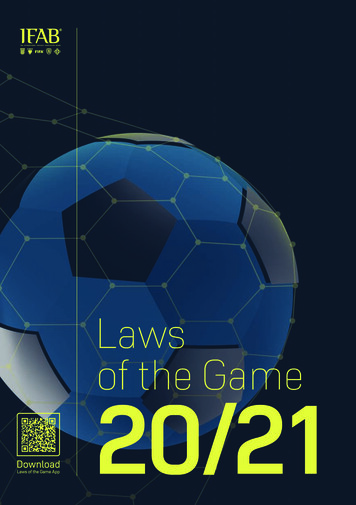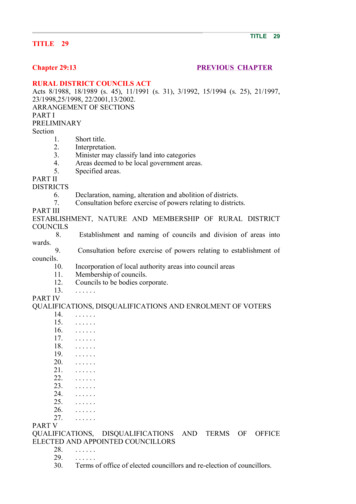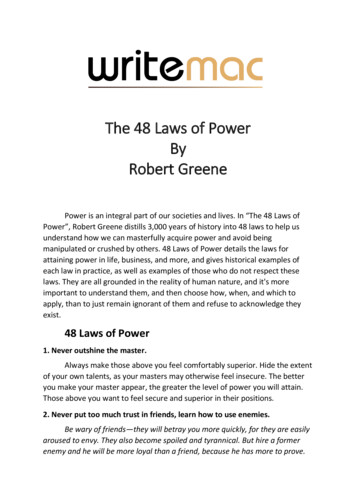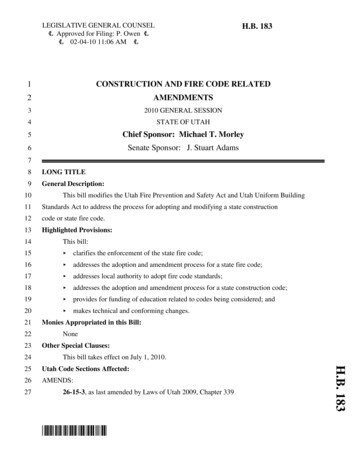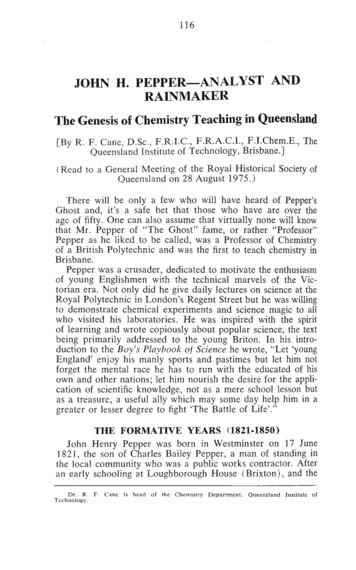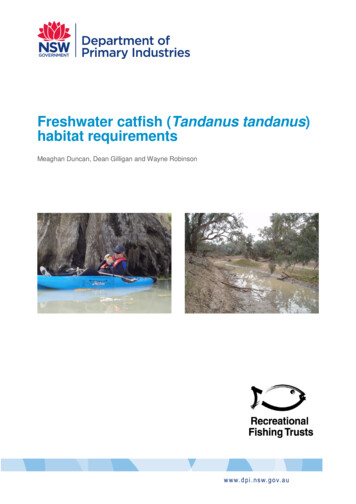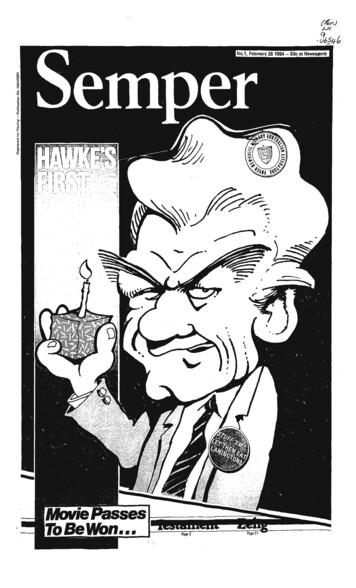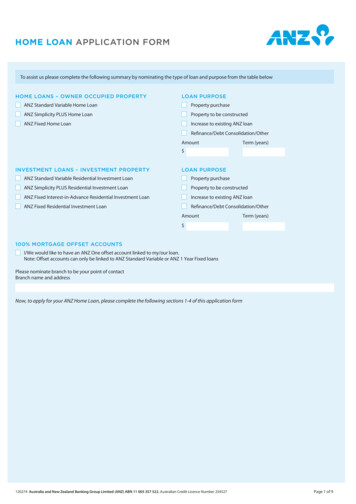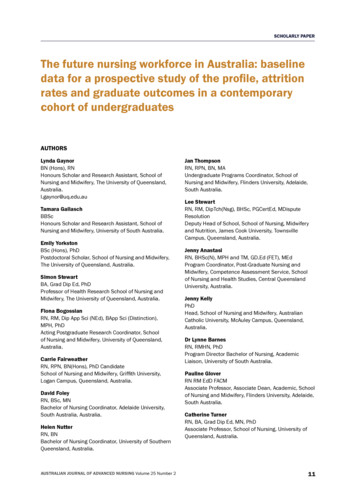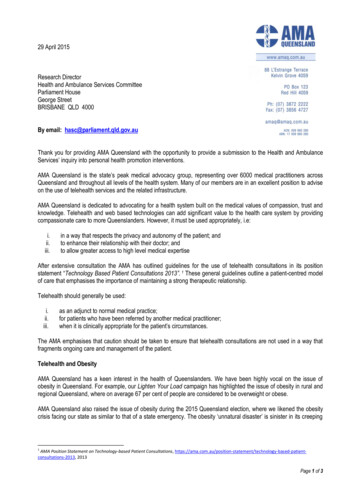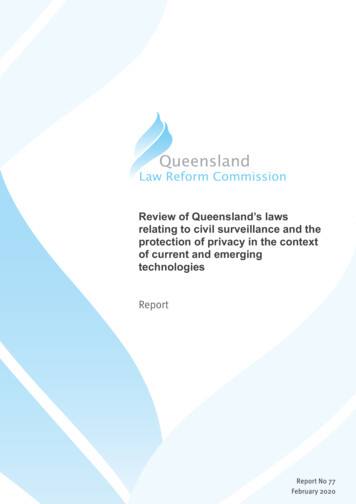
Transcription
Review of Queensland’s lawsrelating to civil surveillance and theprotection of privacy in the contextof current and emergingtechnologiesReportReport No 77February 2020
QueenslandLaw Reform CommissionReview of Queensland’s lawsrelating to civil surveillance and theprotection of privacy in the contextof current and emergingtechnologiesReportReport No 77February 2020
Postal address:Telephone:Facsimile:Email:Website:PO Box 13312, George Street Post Shop, Qld 4003(07) 3564 7777(07) 3564 c.qld.gov.au State of Queensland (Queensland Law Reform Commission) 2020ISBN: 978-0-6481164-4-8
To:The Honourable Yvette D’Ath MPAttorney-General and Minister for JusticeLeader of the HouseIn accordance with section 15 of the Law Reform Commission Act 1968, theCommission is pleased to present its Report, Review of Queensland’s laws relatingto civil surveillance and the protection of privacy in the context of current andemerging technologies.The Honourable Justice David JacksonChairpersonThe Honourable Margaret Wilson QCMemberHis Honour Judge Brian Devereaux SCMemberMs Penelope WhiteMemberDr Nigel StobbsMemberMs Ruth O’GormanMember
COMMISSION MEMBERSChairperson:The Hon Justice David JacksonPart-time members:The Hon Margaret Wilson QCHis Honour Judge Brian Devereaux SCMs Penelope WhiteDr Nigel StobbsMs Ruth O’GormanSECRETARIATDirector:Mr David GrothAssistant Director:Mrs Cathy GreenSecretary:Mrs Jenny MantheySenior Legal Officers:Ms Anita GaleazziMrs Elise HoMs Paula RogersAdministrative Officers:Ms Kahren GilesMrs Brie HenriPrevious Queensland Law Reform Commission publication in this reference:Queensland Law Reform Commission, Review of Queensland’s laws relatingto civil surveillance and the protection of privacy in the context of current andemerging technologies, Consultation Paper, WP No 77 (2018)
Abbreviations and GlossaryAAUSAustralian Association for Unmanned SystemsAAUS and Liberty VictoriaPaper (2015)Australian Association for Unmanned Systems and LibertyVictoria, ‘The Use of Drones in Australia: An Agenda for Reform’(May 2015)ACCCAustralian Competition and Consumer CommissionACCC Digital PlatformsInquiry Report (2019)Australian Competition and Consumer Commission, DigitalPlatforms Inquiry, Final Report (June 2019)ACT Review (2016)D Stewart, ‘Review of ACT Civil Surveillance Regulation’ (Report,June 2016)AHRCAustralian Human Rights CommissionAHRC Discussion Paper(2019)Australian Human Rights Commission, Human Rights andTechnology, Discussion Paper (December 2019)ALRCAustralian Law Reform CommissionALRC Discussion PaperNo 80 (2014)Australian Law Reform Commission, Serious Invasions ofPrivacy in the Digital Era, Discussion Paper No 80 (March 2014)ALRC Report No 123 (2014)Australian Law Reform Commission, Serious Invasions ofPrivacy in the Digital Era, Report No 123 (June 2014)ALRC Report No 108 (2008)Australian Law Reform Commission, For Your Information:Australian Privacy Law and Practice, Report No 108 (May 2008)ALRC Report No 22 (1983)Australian Law Reform Commission, Privacy, Report No 22(1983)APP entityA Commonwealth agency (or its contracted service provider), ahealth service provider, a private sector organisation with anannual turnover of more than 3 million or a business that tradesin personal information. An APP entity is required to comply withthe Privacy Act 1988 (Cth).APPsAustralian Privacy Principles, under the Privacy Act 1988 (Cth)Australian GovernmentIssues Paper: SeriousInvasion of Privacy (2011)Australian Government, ‘A Commonwealth Statutory Cause ofAction for Serious Invasion of Privacy’ (Issues Paper,Department of the Prime Minister and Cabinet, September 2011)Big dataAn extremely large data set that can be mined for patterns,trends and associations, as in relation to human behaviour.CASACivil Aviation Safety AuthorityCCTVclosed circuit televisioncommunication orpublication prohibitionsThe prohibitions under surveillance devices legislation againstthe communication or publication of information obtained fromthe use of a surveillance device.
covert surveillanceSurveillance that is done in such a way that the subject ofsurveillance is unaware that the surveillance is occurring, forexample, where the surveillance device is concealed.the draft BillSurveillance Devices Bill 2020, contained in Appendix FDSDMIPDepartment of State Development, Manufacturing, Infrastructureand PlanningdroneThe terms of reference use the term ‘drones’. The QDS uses theterm ‘drone’ to refer to any remotely controlled or autonomousaircraft or underwater craft. They are also referred to variously asan autonomous underwater vehicle (‘AUV’), remotely pilotedaircraft (‘RPA’), remotely piloted aircraft system (‘RPAS’),unmanned aerial vehicle (‘UAV’), unmanned aerial system(‘UAS’) or unmanned underwater vehicle (‘UUV’).Eyes in the Sky Report(2014)House of Representatives Standing Committee on Social Policyand Legal Affairs, Parliament of Australia, Eyes in the sky: Inquiryinto drones and the regulation of air safety and privacy(July 2014)Eyes in the Sky Report:Government Response(2016)Australian Government, ‘Australian Government Response to theStanding Committee on Social Policy and Legal Affairs Report:Eyes in the Sky: Inquiry into drones and the regulation of airsafety and privacy’ (December 2016)GPSglobal positioning systemICTinformation communication technologyIP ActInformation Privacy Act 2009 (Qld)IPPsInformation Privacy Principles, under the Information Privacy Act2009 (Qld)Joint Working GroupReport (2003)Standing Committee of Attorneys-General and the AustralasianPolice Ministers Council Joint Working Group on NationalInvestigation Powers, Cross-Border Investigative Powers for LawEnforcement, Report (November 2003)LRC IrelandLaw Reform Commission of IrelandLRC Ireland Report No 57(1998)Law Reform Commission of Ireland, Privacy: Surveillance andthe Interception of Communications, Report No 57 (June 1998)NSW ParliamentaryCommittee Report (2016)Standing Committee on Law and Justice, Parliament of NewSouth Wales, Remedies for the serious invasion of privacy inNew South Wales (3 March 2016)NSWLRCNew South Wales Law Reform CommissionNSWLRC Interim ReportNo 98 (2001)New South Wales Law Reform Commission, Surveillance: aninterim report, Report No 98 (February 2001)NSWLRC Issues PaperNo 12 (1997)New South Wales Law Reform Commission, Surveillance, IssuesPaper No 12 (May 1997)
NSWLRC Report No 108(2005)New South Wales Law Reform Commission, Surveillance, ReportNo 108 (May 2005)NSWLRC Report No 120(2009)New South Wales Law Reform Commission, Invasion of Privacy,Report No 120 (April 2009)NZLCNew Zealand Law CommissionNZLC Issues Paper No 14(2009)New Zealand Law Commission, Invasion of Privacy: Penaltiesand Remedies—Review of the Law of Privacy Stage 3, IssuesPaper No 14 (March 2009)NZLC Report No 113 (2010)New Zealand Law Commission, Invasion of Privacy: Penaltiesand Remedies—Review of the Law of Privacy Stage 3, ReportNo 113 (January 2010)NZLC Study Paper No 19(2008)New Zealand Law Commission, Privacy: Concepts and Issues—Review of the Law of Privacy Stage 1, Study Paper No 19(January 2008)OAICOffice of the Australian Information CommissionerOAIC Guideline: Keyconcepts—Consent (2019)Office of the Australian Information Commissioner, ‘Chapter B:Key concepts—Consent’ in Australian Privacy Principlesguidelines (v 1.3, 22 July 2019) -principlesguidelines/ OAIC, Disclosinginformation about patientswith impaired capacity(2019)Office of the Australian Information Commissioner, ‘Chapter 7:Disclosing information about patients with impaired capacity’ inGuide to health privacy (v 1.0, 6 September 2019) ide-tohealth-privacy/ OICOffice of the Information Commissioner (Queensland)OIC Guideline: Applicationsby and for children (2017)Office of the Information Commissioner (Queensland),Guidelines—Access and amendment: Applications by and forchildren (5 June 2017) ications-by-and-for-children .OIC Guideline: Key privacyconcepts—agreement andconsent (2013)Office of the Information Commissioner (Queensland),Guidelines—Privacy principles: Key privacy concepts—agreement and consent (19 July 2013) s/key-privacy-concepts-agreement-and-consent OIC Guideline: Privacy andchildren (2012)Office of the Information Commissioner (Queensland),Guidelines—Privacy principles: Privacy and children(30 July 2012) cyprinciples/privacy-and-children
OIC, Information Sheet:Camera surveillance, video,and audio recording—acommunity guide (2019)Office of the Information Commissioner (Queensland),Information Sheet—Privacy principles: Camera surveillance,video, and audio recording—a community guide (24 September2019) unity-guide overt surveillanceSurveillance that is done in such a way that the subject ofsurveillance is aware that the surveillance is occurring, forexample, where the surveillance device is not concealed.participant monitoringIn general terms, the use of a listening device or an opticalsurveillance device by a party to a private conversation or aprivate activity to record the conversation or activity without theknowledge or consent of the other party or parties.PPRAPolice Powers and Responsibilities Act 2000 (Qld)Privacy ActPrivacy Act 1988 (Cth)QAIQueensland Advocacy IncorporatedQCATQueensland Civil and Administrative TribunalQCCLQueensland Council for Civil LibertiesQDS (2018)Queensland Government, Queensland Drones Strategy(June 2018)QDS Consultation Paper(2017)Queensland Government, ‘Queensland Drones Strategy’(Consultation Paper, Department of the Premier and Cabinet,August 2017)QGCIOQueensland Government Chief Information Office, Department ofHousing and Public WorksQLRC Consultation PaperNo 77 (2018)Queensland Law Reform Commission, Review of Queensland’slaws relating to civil surveillance and the protection of privacy inthe context of current and emerging technologies, ConsultationPaper, WP No 77 (December 2018)QLSQueensland Law SocietyReview of the RTI Act andIP Act (2017)Department of Justice and Attorney-General (Queensland),‘Report on the review of the Right to Information Act 2009 andInformation Privacy Act 2009’ (October 2017)SA Legislative ReviewCommittee Report (2013)Legislative Review Committee, Parliament of South Australia,Report of the Legislative Review Committee into Issues Relatingto Surveillance Devices (November 2013)surveillance deviceslegislationLegislation regulating the use of surveillance devices in eachAustralian jurisdiction, namely: Invasion of Privacy Act 1971 (Qld) Listening Devices Act 1992 (ACT) Surveillance Devices Act 2007 (NSW) and SurveillanceDevices Regulation 2014 (NSW)
* Surveillance Devices Act (NT) and Surveillance DevicesRegulations (NT) Surveillance Devices Act 2016 (SA) and SurveillanceDevices Regulations 2017 (SA) Listening Devices Act 1991 (Tas) and Listening DevicesRegulations 2014 (Tas) Surveillance Devices Act 1999 (Vic) and SurveillanceDevices Regulations 2016 (Vic) Surveillance Devices Act 1998 (WA) and SurveillanceDevices Regulations 1999 (WA)use prohibitionsThe prohibitions under surveillance devices legislation againstusing (or installing, maintaining or attaching) a surveillancedevice for certain purposes.VLRCVictorian Law Reform CommissionVLRC Report No 18 (2010)Victorian Law Reform Commission, Surveillance in Public Places,Report No 18 (June 2010)VLRC Consultation PaperNo 7 (2009)Victorian Law Reform Commission, Surveillance in Public Places,Consultation Paper No 7 (January 2009)VLRC Occasional Paper(2002)K Foord, Defining Privacy, Victorian Law Reform Commission,Occasional Paper (2002)VLRC Information Paper(2001)Victorian Law Reform Commission, Privacy Law: Options forReform, Information Paper (July 2001)Except where otherwise indicated, references to legislation in this Report are references toQueensland legislation.
Table of ContentsEXECUTIVE SUMMARY . iLIST OF RECOMMENDATIONS . ixCHAPTER 1 . 1INTRODUCTION . 1THE TERMS OF REFERENCE . 1The Consultation Paper . 2Submissions . 2The structure of this Report. 3TERMINOLOGY . 4CHAPTER 2 . 5BACKGROUND . 5SURVEILLANCE AND SURVEILLANCE DEVICE TECHNOLOGIES. 5PRIVACY . 7SURVEILLANCE DEVICES LEGISLATION . 9Queensland: Invasion of Privacy Act 1971 . 9Other jurisdictions . 11Criminal penalties . 16Surveillance and law enforcement in Queensland . 17OTHER LAWS RELEVANT TO SURVEILLANCE AND PRIVACY . 17CHAPTER 3 . 19A NEW APPROACH TO REGULATING THE USE OF SURVEILLANCE DEVICES . 19INTRODUCTION . 19The need for new surveillance devices legislation in Queensland . 20THE COMMISSION’S APPROACH . 21Balancing surveillance and privacy . 21Consent . 22Exceptions for authorised use . 22Exceptions for justified and ‘reasonably necessary’ purposes . 23A criminal law and a civil law response . 23The draft Bill . 23ALTERNATIVE APPROACHES . 24RECOMMENDATION . 28CHAPTER 4 . 29PRELIMINARY MATTERS . 29THE APPLICATION OF THE DRAFT BILL . 29The application of the draft Bill to all persons . 29Relationship with other laws. 29THE DEFINITION OF SURVEILLANCE DEVICE AND RELATED DEFINITIONS . 32Approaches to the definition of surveillance device . 32Submissions . 34The Commission’s view . 37
THE DEFINITION OF CONSENT . 42The meaning of consent . 42Submissions . 45The Commission’s view . 47RECOMMENDATIONS . 51CHAPTER 5 . 55CRIMINAL PROHIBITIONS ON THE USE OF SURVEILLANCE DEVICES . 55INTRODUCTION . 55SURVEILLANCE DEVICES LEGISLATION . 56SUBMISSIONS. 57Prohibition on the use of a surveillance device for particular purposes . 57Criminal penalty. 61Exceptions to the prohibition on the use of a surveillance device . 62THE COMMISSION’S VIEW . 78The approach of the draft Bill . 78ELEMENTS OF THE USE PROHIBITIONS . 79Intention. 79Use, install or maintain surveillance devices . 82Prohibited uses. 84Private conversations and activities . 86Tracking devices and data surveillance devices . 92Parties . 93Consent . 95Criminal penalty. 100EXCEPTIONS TO THE USE PROHIBITIONS . 101Participant monitoring . 102Protection of lawful interests . 103Public interest . 111Safety and wellbeing . 120Location and retrieval of a lost or stolen vehicle or other thing. 121Authorised under another Act of the State or an Act of the Commonwealth . 123Prescribed circumstances . 126Security providers and insurance adjusters . 127Not for communication or publication to a person who is not a party . 129Lawful purpose . 130RECOMMENDATIONS . 130CHAPTER 6 . 137CRIMINAL PROHIBITIONS ON THE COMMUNICATION OR PUBLICATION OFSURVEILLANCE INFORMATION . 137INTRODUCTION . 137SURVEILLANCE DEVICES LEGISLATION . 138Queensland . 138Other jurisdictions . 140SUBMISSIONS. 143Communication or publication prohibitions . 143Exceptions to the communication or publication prohibitions . 144THE COMMISSION’S VIEW . 148The approach of the draft Bill . 148ELEMENTS OF THE COMMUNICATION OR PUBLICATION PROHIBITIONS . 149Intention or knowledge . 149
Surveillance information that the communication or publication prohibitions apply to. 149Consent . 150Criminal penalty. 150EXCEPTIONS TO THE COMMUNICATION OR PUBLICATION PROHIBITIONS . 151Communication or publication in legal proceedings. 152Communication or publication to protect that person’s lawful interests . 153Communication or publication in the public interest. 156Communication or publication for safety and well-being . 161Communication or publication authorised under another Act or prescribed by regulation 162Communication or publication by security providers and loss adjusters . 163Communication or publication to a person with a reasonable interest in thecircumstances . 164Communication or publication in the performance of a duty. 164Communication or publication by a person who obtained knowledge other than by unlawfuluse of the device . 166Communication or publication to a party . 166RECOMMENDATIONS . 167CHAPTER 7 . 171ANCILLARY MATTERS . 171INTRODUCTION . 171OTHER PROHIBITIONS . 171Possession of records obtained from the prohibited use of surveillance devices . 171Possession, manufacture, supply or advertising of surveillance devices . 173Submissions . 174The Commission’s view . 175USE OF A SURVEILLANCE DEVICE TO HARRASS, INTIMIDATE OR HINDER APERSON . 176Submissions . 178The Commission’s view . 179UNLAWFUL ENTRY OF DWELLING HOUSES . 180The Commission’s view . 181CORPORATE OFFICER LIABILITY . 181Submissions . 182The Commission’s view . 183ADMISSIBILITY OF EVIDENCE OBTAINED FROM THE UNLAWFUL USE OF ASURVEILLANCE DEVICE. 183Submissions . 186The Commission’s view . 186NON-PUBLICATION ORDERS . 187The Commission’s view . 189FORFEITURE ORDERS . 190Submissions . 191The Commission’s view . 191RECOMMENDATIONS . 192CHAPTER 8 . 197GENERAL OBLIGATIONS NOT TO INTERFERE WITH SURVEILLANCE PRIVACYOF INDIVIDUALS . 197INTRODUCTION . 197SUBMISSIONS. 197APPROACHES IN OTHER JURISDICTIONS . 199
Breach of a criminal prohibition as ground for a civil complaint . 199Breach of legislative principles as ground for a civil complaint . 200Separate civil ‘tort’ or cause of action . 202THE LEGISLATIVE CONTEXT IN QUEENSLAND . 207THE COMMISSION’S VIEW . 207ELEMENTS OF THE RECOMMENDED APPROACH . 209Statement and scope of the general obligations .
Ms Paula Rogers Ms Kahren Giles Mrs Brie Henri . Previous Queensland Law Reform Commission publication in this reference: Queensland Law Reform Commission, Review of Queensland's laws relating to civil surveillance and the protection of privacy in the context of current and emerging technologies, Consultation Paper, WP No 77 (2018)
